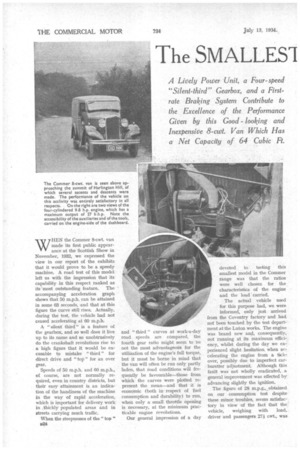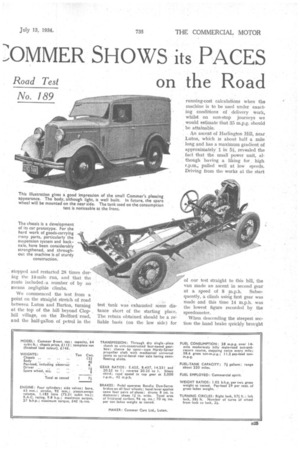The SMALLES1 MMER SHOWS its PACES
Page 38

Page 39

Page 40

If you've noticed an error in this article please click here to report it so we can fix it.
on the Road
Road Test
No. 189
A Lively Power Unit, a Four-speed "Silent-third" Gearbox, and a Firstrate Braking System Contribute to the Excellence of the Performance Given by this Good looking and Inexpensive 8-cwt. Van Which Has a Net Capacity of 64 Cubic Ft.
WHEN the Commer 8-cwt van made its first public appearance at the Scottish Show in November, 1932, we expressed the view in our report of the exhibits that it would prove to be a speedy machine. A road test of this model left us with the impression that its capability in this respect ranked as its most outstanding feature. The accompanying acceleration graph shows that 50 m.p.h. can be attained in some 63 seconds, and that at this figure the curve still rises. Actually, during the test, the vehicle had not ceased accelerating at 60 m.p.h.
A "silent third' is a feature of the gearbox, and so well does it live up to its name and so unobtrusively do the crankshaft revolutions rise to a high figure that it would be excusable to mistake " third " for direct drive and "top" for an over gear.
Speeds of 50 m.p.h. and 60 m.p.h., of course, are not normally required, even in country districts, but their easy attainment is an indication of the handiness of the machine in the way of rapid acceleration, which is important for delivery work in ;thickly populated areas and in streets carrying much traffic.
When the steepnesses of the " top " at and " third" curves at work-a-day road speeds are compared, the fourth gear ratio might seem to be not the most advantageous for the utilization of the engine's full torque, but it must be borne in mind that the van will often be run only partly laden, that road conditions will frequently be favourable—those from which the curves were plotted represent the mean—and that it is economic (both in• respect of fuel consumption and durability) to run, when only a small throttle opening is necessary, at the minimum practicable engine revolutions.
Our general impression of a day devoted to tasting this smallest model in the Commer range was that the ratios were well chosen for the characteristics of the engine and the load" carried.
The actual vehicle used for this purpose had, we were informed, only just arrived from the Coventry factory and had not been touched by the test department at the Luton works. The engine was brand new and, consequently, not running at its maximum effici, ency, whilst during the day we experienced slight hesitation when accelerating the engine from a tic kover, possibly due to imperfect carburetter adjustment. Although this fault was not wholly eradicated, a general improvement was effected by advancing slightly the ignition.
The figure of 28 na.p.g.,_obtained on our consumption test despite these minor troubles, seems satisfactory in view of the fact that the vehicle, weighing with load, driver and passengers 271 cwt., was stopped and restarted 28 times during the 14-mile run, and that the route included a number of by no means negligible climbs.
We commenced the test from a point on the straight stretch of road between Luton and Barton, turning at the top of the hill beyond Clophill village, on the Bedford road, and the half-gallon of petrol in the
test tank was exhausted some distance short of the starting place. The return obtained should be a reliable basis (on the low side) for
running-cost calculations when the machine is to be used under exact. ing conditions of delivery work, whilst on non-stop journeys we would estimate that 35 m.p.g. should be attainable.
An ascent of Harlington Hill, near Luton, which is about half a mile long and has a maximum gradient of approximately 1 in 5i-, revealed the fact that the small power unit, although 'having a liking for high r.p.m., pulled well at low speeds. Driving from the works at the start
of our test straight to this hill, the van made an ascent in second gear
at a speed of 8 m.p.h. Subsequently, a climb using first gear was made and this time 14 m.p.h. was the lowest figure recorded by the speedometer.
When descending the steepest section the hand brake quickly brought
the machine to rest, whilst it functioned equally well in the stop-and restart test. There was, needless to say, no difficulty in moving away from rest up the slope.
Both our hill-climbing and acceleration tests revealed the advantages
which accrue from having a choice of four close gear ratios and by using them.
Previous experience of Commer vehicles led us to expect the brakes of the 8-cwt. van to be highly efficient, and this proved to he the case. They are cable-operated and of the self-energizing type, the eight shoes in the drums of all four wheels being applied by the lever or the pedal through separate mechanisms. Whichever control is used, the retardation, as can be seen from the braking graph, is excellent. We carried out no test with simultaneous operation of lever and pedal, as with the latter alone the wheels can be locked.
Two Improvements on the Previous Design.
Lnvax shock absorbers are now included in the chassis equipment and should prove a useful addition, as the machine has a slight tendency to roll when cornering fast. Another improvement to be incorporated in subsequent models is the mounting of the spare wheel on the near side instead of the off side. We learned this through drawing attention to the difficulty of entering and leaving the driver's seat, which is caused by the spare wheel preventing the full opening of the door. In a de-• livery van this is a distinct disadvantage and it should be rectified—as we understan I it will be—without delay.
The absence of vibration from the engine which, with the gearbox, is a compact and neat unit having a three-bearing crankshaft, is due in no small part to the fact that it is mounted on rubber. It is supported at two points at the front and one at the rear. The accessibility of the auxiliarie's, distributor and contact breaker, dynamo,. carburetter, etc., is noteworthy.
Attention has been paid to the simplification of maintenance throughout the chassis. Accessibility of the tool kit is also good. Accompanying illustrations show how the items are carried under the bonnet. In this connection, the bonnet clip
rt2f3
should be mentioned; it is a simple and ingenious device, secure and easy to operate.
Despite its low weight the body is strongly built. It has full-width doors which, at the rear, are held shut by a haadle-operated bolt. In these doors there are windows which, although large enough to give the driver an adequate look out, would be improved by being made wider. The driver's seat is very comfortable, and a seat beside it is available if required.
Gear changing is an easy matter, whilst the dutch is smooth and light in operation. Slightly more pressure than usual is needed on the accelerator pedal ; thus one can almost rest one's foot upon it, which gives steadier control and less fatigue. Steering is excellent at all speeds, except for the fact that the wheel on the model we tested became progressively harder to turn with an increasing lock. We do nof imagine this to be a fault in design, but to he due to incorrect adjustment or the need for lubrication.
Final Testing and Adjustment Essential.
Most of the few criticisms we have found cause to make are matters of final adjustment. We have drawn attention to them, however, in order to stress the importance of the final. testing to which models should in variably be subjected by all maimfacturers before delivery, and of the buyer satisfying himself that such minor faults have been rectified before he takes the machine over.
This Commer 8-cwt. van, which has a capacity of 64 cubic ft., is subject to a tax of £15. In addition to the price quoted in the accompanying table, a charge of £8 is made for standard painting or £5 for finishing in cellulose. Its appearance is excellent and should constitute an asset to any business. The reputation. of its maker is a guarantee of the quality of its workmanship, and the annual maintenance and running expenditure should be a moderate sum to pay for the performance that it will afford.




























































































